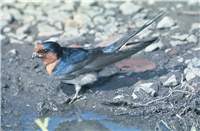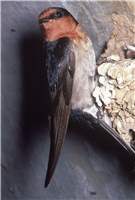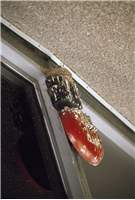Family
Hirundinidae
Genus
Hirundo
Species
neoxena
Threats/Control Methods - Regional
This bird has fared well from land clearing and urban development and is not exposed to many threats. In its high numbers, these swallows can easily become a nuisance to humans from noise and contaminating areas with their faeces. No formal control methods are currently being carried out, however a permit can be obtained from the Department of Environment and Water Resources.
Threats/Control Methods - Local
Free roaming domestic pets will attack this small suburb dwelling bird.
Local/Urban Actions
Ensuring the birds are excluded from roosting space will prevent damage. Keep doors to buildings closed in the hours around sunset and install nets under rafters and eaves in areas where roosting indoors may become a problem. To minimise the threat to all birds, cats are best provided with a stimulating indoor environment and an outdoor enclosure.
Common Names
Welcome Swallow, Australian Swallow, House Swallow
Distinguishing Features
Welcome Swallows have slender, streamlined bodies and long tapered wings with a forked tail. They have a dark, metallic blue back with a white chest and underbelly. Their neck and forehead is a rusty-red colour, which is very pale on young birds.
Survey Techniques
Call and visual identification.
Species Call
Twittering chatter of 'tsi-tswit-tsee', soft warblings or a sharp whistle when alarmed.
Similar Species
Other swallow species are far less common, but very similar looking. The Barn Swallow (Hirundo rustica) has a black band below its rusty coloured throat. Fairy Martins (Hirundo ariel ) can also be confused with Swallows, but they are noticeably shorter with a bright white rump.
Distribution
Most common in southeastern Australia, TAS and southwest WA, with less frequency in QLD and central Australian regions.
Country of Origin
Australia
Conservation (Pet/Pest) Status - Regional
Population numbers vary throughout the year, seeming stable overall (COG).
Conservation (Pet/Pest) Status - National
Secure, not listed under the EPBC Act 1999.
LSCCES Population
The species was found in moderate numbers across the Lower Sullivans Creek Catchment, excluding BMt and Turner.
Associated vegetation community
Welcome Swallows are found in most vegetation communities and suburban area, avoiding very dense forests and arid regions.
Limiting Resources
Urban or regional clearings provide foraging space and buildings and other structures provide nesting site for these swallows. Humans also contribute to excess water and an abundance of insects, making resources abundant in most suburban areas.
Breeding
The Swallow's nest is an open cup of mud and grass attached to a usually man-made structure. Both males and females build the nest, while the female incubates the 3-5eggs for 21 days. The young are dependant for another 21 days and are feed by both parents. In Canberra, most breeding activity takes place from early October to the end of December.
Behaviour
In the suburbs, Welcome Swallows can be seen nesting under the shelters of petrol stations. They are also commonly seen on wires, posts or other suburban perches. It is a very social species, breeding and roosting in groups of up to 100.
Functional Group
Food Species
Welcome Swallows feed on a wide variety on insects. They catch prey in flight, using their acrobatic flying skills. If insects are plentiful, they will feed in large flocks.
Predators
Both domestic and feral Cats (Felis catus) in the region often prey upon Welcome Swallows.
Interesting Fact
Insects are guided into the Welcome Swallow's wide, open mouth with the help of short bristles bordering the bill. These bristles also help protect the bird's eye.
References - (reader suitability of references, P=Primary teachers, S=Secondary students, T=Tertiary students and researchers)
Books:Simpson and Day. 1993. Field Guide to the Birds of Australia. Forth Ed. Penguin Books. Victoria. Australia P, S, T
Morcombe, M. 2000. Field Guide to Australian Birds. Steve Parish Publishing. Archerfield. Australia P, S, T
Schodde, R. and Tideman, S. (eds) 1990. Reader's Digest Complete Book of Australian Birds (2nd Edition). Reader's Digest Services Pty Ltd. Sydney. P, S, T
Veerman, P. 2003. Canberra Birds: A report on the first 21 years of the garden bird survey. Philip Veerman and Canberra Ornithologists Group. Canberra. S, T
Internet: Birds in Backyards 2006. [online]. Available at:http://www.birdsinbackyards.net P, S, T
Canberra Ornithological Group (COG). 2004. Birds of Canberra Gardens. COG and the ACT Department of Urban Services. [online]. Available at:http://garden.canberrabirds.org.au/ P, S, T
Online Publications:Department of Environment and Conservation. 2006. Prevention and Control of Damage by Animals in WA: Swallows (Hirundo sp.) Department of Environment and Conservation. Western Australia. [online]. Available at: http://www.naturebase.net/component/option,com_docman/task,doc_details/gid,275/ P, S, T Nix, H. and Cunningham, R. 2006. Birds of the Lower Sullivans Creek Catchment, Canberra ACT. Prepared for the Life in the Suburbs project using data from the Lower Sullivans Creek Catchment Ecological Survey (LSCCES). Australian National University. Canberra. [online]. Available at: http://www.lifeinthesuburbs.com.au/category.php?id=65 S, T



 Top
Top Top
Top